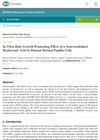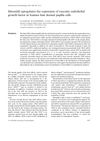TLDR Latanoprost increases VEGF protein in human cells, which may help hair growth.
In the 2006 study, researchers investigated the effects of latanoprost on vascular endothelial growth factor (VEGF) protein synthesis in human dermal papilla cells (DPCs). They treated DPCs with five different concentrations of latanoprost for 72 hours and measured VEGF protein levels using ELISA kits. The results showed that VEGF protein synthesis was significantly increased in the DPCs treated with latanoprost at all concentrations except for the lowest one at 0.16 ng/mL. The increase in VEGF protein synthesis was dose-dependent. The study concluded that latanoprost stimulates VEGF protein synthesis in human DPCs, suggesting a potential role in promoting hair growth.
 5 citations
,
January 2021 in “BioMed Research International”
5 citations
,
January 2021 in “BioMed Research International” Noncrosslinked hyaluronic acid helps human hair cells grow and could be a potential hair loss treatment.
 17 citations
,
May 2015 in “Nanomedicine: Nanotechnology, Biology and Medicine”
17 citations
,
May 2015 in “Nanomedicine: Nanotechnology, Biology and Medicine” Scientists created tiny particles loaded with a hair growth drug, minoxidil, that specifically target hair follicles and skin cells to potentially improve hair growth.
January 2007 in “Linchuang pifuke zazhi” Licorice may help increase hair growth.
1 citations
,
January 2007 in “Chinese Journal of Dermatology” Baicalin may help hair growth by increasing VEGF secretion.
56 citations
,
June 2002 in “Biomaterials” Controlled release of VEGF in a collagen hydrogel boosts hair growth in mice.
 192 citations
,
March 1998 in “British Journal of Dermatology”
192 citations
,
March 1998 in “British Journal of Dermatology” Minoxidil boosts growth factor in hair cells, potentially promoting hair growth.
 23 citations
,
July 1996 in “Archives of Dermatological Research”
23 citations
,
July 1996 in “Archives of Dermatological Research” bFGF, VEGF, and minoxidil decrease collagen production in hair cells, possibly affecting hair growth.



